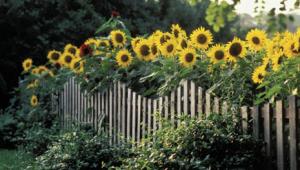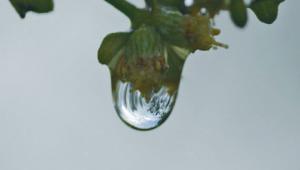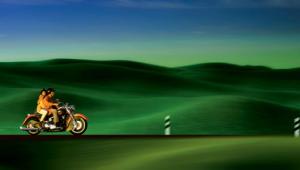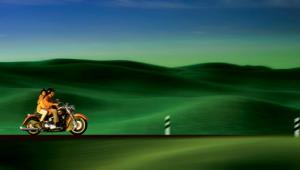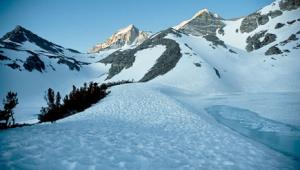Unfortunately, it's been a while since the last time I've been to Hawaii, I must say I really miss the islands! I'm about to head to the best beaches on Phuket though, so they will be more than enough to fill my love for beautiful beaches, I might discover sights as spectacular as these ones!
Photographing Kauai's Exotic Beauty Page 2
Don't turn around on Highway 550 and head south after you experience
Waimea Canyon, as this road quickly enters Koke'e State Park when you
continue north. Near the end of the road, you'll be rewarded by one of
the most spectacular views on the island--the Kalalau Lookout. This panoramic
viewpoint overlooks the Kalalau Valley, which features dramatically sculptured
sea cliffs, beautiful vegetation, and the ocean 4000 feet below. Not only did
I get there in the morning (the time of day that locals recommended), I felt
very fortunate that the view wasn't obstructed by clouds, as it often
is. A little fog was just drifting away from one of the peaks, so I quickly
grabbed my Canon EOS Elan 7ne, adjusted my zoom lens on its 28mm setting, and
shot several wide views. I switched to my 300mm lens and singled out a cliff
that met the ocean, with a tour boat going by.
We decided to hike on the Awaawapuhi Trail, which was a three-mile (one way)
trek through a forested area in Koke'e State Park. We walked past thick
groves of trees and dense ferns for the entire hike. (I've read that many
of the wild berries that grow alongside this trail are edible, but we didn't
sample any.) At the end of the trail 2500 feet above the ocean, we looked out
onto a portion of the jagged Na Pali cliffs. A few helicopters giving scenic
tours buzzed overhead, and the only other signs of life were a rooster, a hen
and several chicks. These very colorful roosters, once shipped to Kauai for
cock fights, now populate the island in great numbers and seem to turn up everywhere.
A light rain cooled us off as we hiked back--a relief as the trail was
primarily uphill in this direction.
 |
|
|
Heading north on Highway 56, there are a string of beautiful beaches along
the way. Kilauea Lighthouse is a popular attraction at the northern tip of Kauai,
located on a narrow peninsula. This lighthouse was built in 1913, and once guided
ships heading to and from the Orient until the 1970s, when it was replaced by
a low-maintenance light beacon. Nonetheless, Kilauea Lighthouse remains as a
dramatic, lone sentinel that's often photographed. Nearby is the Kilauea
Point National Wildlife Refuge, which is home to a number of nesting seabirds.
From a viewpoint above, you can photograph the lighthouse and peninsula, and
birdwatch if you so desire.
After Highway 56 meets 560, you'll come to Hanalei, a colorful, laid-back
town with shops and restaurants, which is also a busy trade center for surrounding
macadamia nut plantations. Here, I photographed a wide-angle view with a 20mm
lens of Hanalei's historic Wai'oli Hui'ia Church to include
some nearby palm trees swaying in the breeze.
By continuing northwest, you'll reach Lumaha'i Beach, where the
movie South Pacific was filmed. Located literally at the end of the road is
Ke'e Beach, possibly the most visited beach in Kauai. The spectacular
Kalalau Trail (which we attempted the following day) begins at the western end
of this beach. When photographing some of these coastlines in the morning and
in the evening, I found that a 2X split neutral-density filter helped to even
out the exposure of a bright sky against a shady foreground.
 |
|
|
A Taste of the Kalalau Trail
This trail is an 11-mile trek that ends in paradise at the Kalalau Valley, according
to the accounts I've read. However, I didn't make it this far. Instead,
my husband and I hiked a four-mile loop to Hanakapi'ai Beach, which represents
the most heavily visited portion of this popular trail.
After an initially steep climb over muddy terrain, rocks and tree roots, the
trail borders the cliffs that overlook the spectacular Na Pali coast. Every
turn afforded a great view of the coast and numerous photo opportunities. The
azure blue sea was on our right side, as we trekked through tropical vegetation.
After a thousand-foot elevation gain, there were steep drop-offs (but the thick
vegetation gave me a false sense of security). The first two miles of this trail
are truly like Grand Central Station, because of the crowds of people that trek
this portion of it. However, the remainder of the trail requires a permit and
is not for novice hikers. Just shy of two miles, the trail descends down to
Hanakapi'ai Beach. A rope-assisted crossing will help you across Hanakapi'ai
stream to the beach beyond. An unmarked trek crosses the stream several times
and leads to the beautiful Hanakapi'ai Falls.
To take even the brief portion of the trail that we embarked on, you must wear
sturdy hiking shoes, and expect that they'll be covered with red mud.
A hiking stick is helpful, as the terrain is very uneven. And last but not least,
you must protect your camera gear from the elements. When I wasn't using
my camera, I wrapped it in a plastic bag that I got from our hotel room, and
was glad I did, as it rained intermittently during our hike that morning. However,
the rain yielded some beautiful rainbows along the way, in addition to the vistas
along the coast. A polarizing filter saturated these colors.
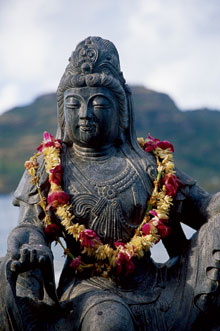 |
|
|
The Kalalau trail offered the most dramatic scenery of our Kauai trip, and
the first two miles were only the tip of the iceberg! If you visit Kauai, you've
got to see the Na Pali Coast either on foot, or via a scenic tour on a helicopter
or boat. There are no roads through this area. You'll come away with some
striking images, no matter which way you choose to see this fabulous coastline.
Kauai is a mecca for photographers and those who love nature at its best. So
buy a plane ticket, and pack up your camera gear and more memory cards or film
than you think you'll need.
Five Travel Reminders
1. If you're traveling by air and shooting with film at your destination,
ask airport security to hand-check your film. X-ray equipment is very powerful
and can damage your film. You'll find that security personnel will frequently
honor your request.
2. When hiking, take only as much equipment as you think you'll need.
Don't overload yourself with gear.
3. As with most scenic spots, do your homework ahead of time. Find out where
the best photo opportunities are and the time of day that's best to shoot
them. In addition to planning, be open for discovery.
4. Bring several lenses, ranging from wide-angle to telephoto. A tripod is always
a must for sharp images. To lighten your load, one long-range zoom lens may
suffice.
5. It's imperative to protect your camera gear in wet climates like Hawaii.
Bring a backpack with protected compartments or some sort of waterproof protection.
If you want to go snorkeling, invest in a compact, waterproof camera.
- Log in or register to post comments








